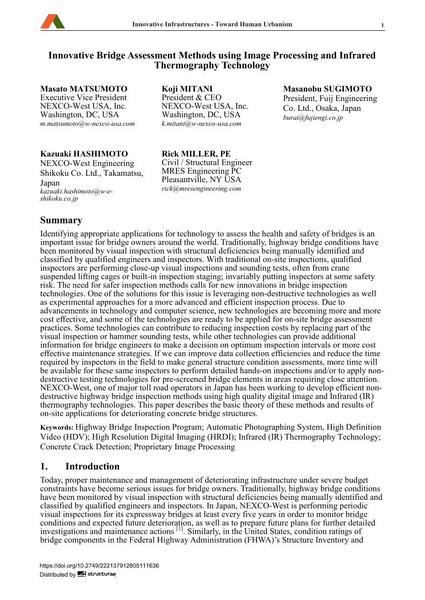Innovative Bridge Assessment Methods using Image Processing and Infrared Thermography Technology

|
|
|||||||||||
Détails bibliographiques
| Auteur(s): |
Masato Matsumoto
Koji Mitani Masanobu Sugimoto Kazuaki Hashimoto Rick Miller |
||||
|---|---|---|---|---|---|
| Médium: | papier de conférence | ||||
| Langue(s): | anglais | ||||
| Conférence: | 18th IABSE Congress: Innovative Infrastructures – Towards Human Urbanism, Seoul, Korea, 19-21 September 2012 | ||||
| Publié dans: | IABSE Congress Seoul 2012 | ||||
|
|||||
| Page(s): | 1181-1188 | ||||
| Nombre total de pages (du PDF): | 8 | ||||
| DOI: | 10.2749/222137912805111636 | ||||
| Abstrait: |
Identifying appropriate applications for technology to assess the health and safety of bridges is an important issue for bridge owners around the world. Traditionally, highway bridge conditions have been monitored by visual inspection with structural deficiencies being manually identified and classified by qualified engineers and inspectors. With traditional on-site inspections, qualified inspectors are performing close-up visual inspections and sounding tests, often from crane suspended lifting cages or built-in inspection staging; invariably putting inspectors at some safety risk. The need for safer inspection methods calls for new innovations in bridge inspection technologies. One of the solutions for this issue is leveraging non-destructive technologies as well as experimental approaches for a more advanced and efficient inspection process. Due to advancements in technology and computer science, new technologies are becoming more and more cost effective, and some of the technologies are ready to be applied for on-site bridge assessment practices. Some technologies can contribute to reducing inspection costs by replacing part of the visual inspection or hammer sounding tests, while other technologies can provide additional information for bridge engineers to make a decision on optimum inspection intervals or more cost effective maintenance strategies. If we can improve data collection efficiencies and reduce the time required by inspectors in the field to make general structure condition assessments, more time will be available for these same inspectors to perform detailed hands-on inspections and/or to apply non- destructive testing technologies for pre-screened bridge elements in areas requiring close attention. NEXCO-West, one of major toll road operators in Japan has been working to develop efficient non- destructive highway bridge inspection methods using high quality digital image and Infrared (IR) thermography technologies. This paper describes the basic theory of these methods and results of on-site applications for deteriorating concrete bridge structures. |
||||
